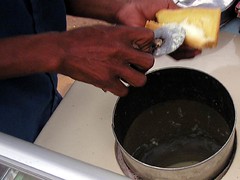Just as I was finishing my year-long opus on the microbiological make-up of Phnom Penh’s streetside icecream, I discovered that the French beat me to it by almost ten years. Damn you, Institut Pasteur du Cambodge. To wit:
A study of the microbiological quality of ice creams/sorbets sold on the streets of Phnom Penh city was conducted from April 1996 to April 1997. Socio-demographic and environmental characteristics with two ice/ice creams samples were collected from vendors selected in the city. A total of 105 vendors and 210 ice/ice creams samples were randomly selected for the study period. Ice/ice cream vendors in the streets of Phnom Penh were adults (mean age: 28 years old) with a male predominance (86.5%). Mean educational level of vendors was 5 years with no training in mass catering. Most ice creams and sorbets (81.7%) were made using traditional methods.
Microbiological analysis performed in the laboratory of Pasteur Institute of Cambodia indicated the poor bacteriological quality of the samples. The proportions of samples classified unsafe according to microbiological criteria were 83.3% for total bacterial count at 30 degrees C, 70% for total coliforms, 30% for faecal coliforms, 12.2% for Staphylococcus aureus and 1.9% for presence of Salmonella spp. These bacterial results suggest that many other food products sold in the streets may be similarly poor. Safety measures should be undertaken to avoid potential threats. Regulation of the street food sector should be part of a larger strategy for enhanced food safety and environmental quality in the city.
Things have either improved in the last ten years or I just happen to pick the 16.7% of icecream vendors who are free from bacteria, assuming that there is a high degree of cross-contamination and my secret superpower is not the ability to digest anything.
The full report has some great demographic info to spice up your icecream vendor-related dinner party conversation:
- Average number of years in the profession was 2 years.
- Average number of working days was 6 per week and each vendor worked 47 weeks during the year.
- 65.4% of vendors made their own icecream, 16.3% bought from other small vendors, and 18.3% bought theirs from a larger icecream business.
- The average number of portions sold per day was 177.
- The average daily profit was US$2.30
My only question is: how do I get funding to study street food for a whole year?
See: Kruy Sl, Soares Jl, Ping S et al. Microbiological quality of ” ice, ice cream sorbet” sold on the streets of Phnom Penh; April 1996-April 1997. Bull Soc Pathol Exot 2001; 94 (5): 411-414. Original PDF in French. Includes photos of the four distinct modes of icecream vendor .
Previously on Phnomenon: Icecream Sandwich on Wheels

Ice cream cones AND air condition at Big A for just 2,100 riel per scoop. Not too sure about faecal coliforms or Salmonella; that probably cost extra.